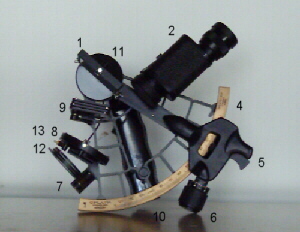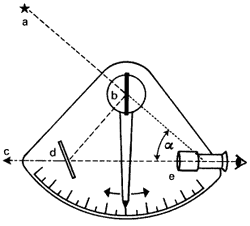Sextant
In 1700 Issac Newton designed a
concept sketch of an instrument for angle measurement with the help of mirrors.
But it was uncared till 1742, the year of his death. In order to 1730 John
Hadley, an English astronom and mathematician and Thomas Godfrey, an optician
and inventor in the British colony of America, invented independently, the
first sextant and turned in their sketches to the Royal Society. The construction
of Hadley was an octant, this proved as more useful and was the precursor of
all further sextants. The name sextant comes from the angle scala that 60°
(the sixth part of a circle) comprises. It consits of a telescope,
the turning mirror and a rotation arm that can be adjusted to left or right
in an area from 0-60 degrees. Thus, the turning mirror, that is atached on
the rotations arm, can be adjusted that the sunbeams become guided through
the ocular. In the ocular view the sun is associated on the highness of the
horizon. So the angle is found under that the sun stands to the horizon.
For optical reasons the actuall angle of the sun is the double of the value
of the angle scale of the sextant. It is not only a navigation instrument,
for example, the sextant is equally used by researchers, surveyors and all
persons that calculate the distance with the help of angle measurement.
This sextant and another one
are donations of the former Seefahrtschule
Grünendeich.

|
01.
Index Mirror 02. Telescope 03. Aliddade 04. Graduated arc 05. Quick release 06. Micrometer drum 07. Shades 08. Horizon glass 09. Shades 10. Screwed cap (for battery) 11. Index mirror adj. screw 12. Horizon mirror adj. screw 13. Horizon mirror adj. screw |
|
schematic structure of a sextant
|
b = mobile mirror (fixed on the locator) c = horizon d = semipermeable steady mirror e = telescope |
Astrid Zscheyge und Nadja Striesche,
VT 02, 19.06.03

